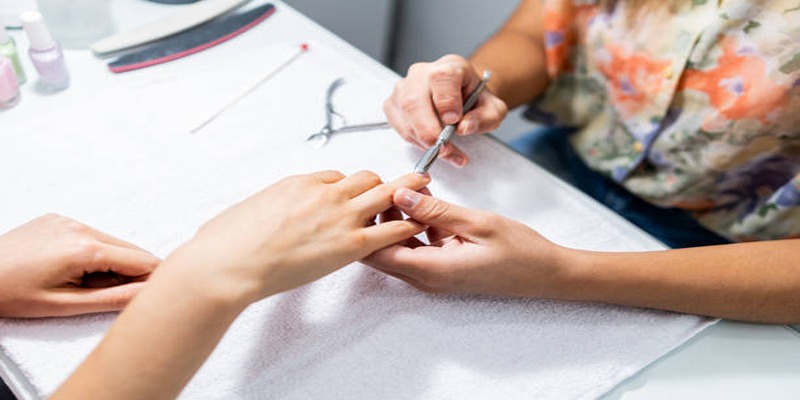Should You Really Cut Your Cuticles? A Comprehensive Guide
Nov 01, 2024 By Noa Ensign
Caring for your nails is an important part of personal hygiene, but the question of whether or not to cut your cuticles often sparks debate. Cuticles are the thin strips of skin at the base of your nails, acting as barriers against bacteria and fungi. While trimming them might make your nails look cleaner and more polished, it can also expose you to infections if not done carefully. In this guide, we'll explore whether cutting your cuticles is truly necessary, the potential risks involved, and how to maintain healthy nails without compromising their natural defenses. By understanding the role of cuticles and the best practices for nail care, you can make informed decisions about your manicure routine that promote both beauty and health.
What are Cuticles?

Cuticles are the thin, translucent layer of dead skin cells that form a protective seal at the base of your nails. They act as a barrier to protect the delicate nail bed from infection-causing germs and dirt.
Role of cuticles in nail health
The primary function of cuticles is to prevent bacteria, fungi, and other harmful substances from entering your nails. They also help retain moisture in the nail matrix, promoting healthy nail growth. Moreover, cuticles protect your nails from trauma and injury by forming a seal between the nail plate and the surrounding skin.
When should you trim your cuticles?
There is no universal rule for when you should trim your cuticles. Some people have naturally smaller or less noticeable cuticles that require minimal maintenance, while others may have larger or overgrown cuticles that need more frequent trimming. It's important to pay attention to your individual nail health and adjust your routine accordingly.
Pros of Cutting Cuticles
- Aesthetics: Cuticles can sometimes appear dry, rough or overgrown, giving your nails an unkempt look. Trimming them helps to improve the overall appearance and give a neater nail bed.
- Better application of polish: Cutting cuticles creates more surface area on the nail bed, making it easier to apply nail polish smoothly without getting it on the skin around the nails.
- Easier access for DIY manicures: If you prefer to do your own manicures at home, cutting your cuticles can make it easier to work with as you won't have excess skin getting in the way.
- Reduced risk of hangnails: Overgrown cuticles can lead to painful and unsightly hangnails, which can be prevented by trimming them regularly.
- Smooth nail growth: If your cuticles tend to grow upwards, trimming them can help guide the nail to grow in a straighter line.
Cons of Cutting Cuticles
- Increased risk of infection: The biggest downside of cutting cuticles is the potential for introducing bacteria or fungus into the open wound created by trimming. This can lead to infections such as paronychia, which is characterized by redness, swelling and pus around the nail.
- Over-trimming: It's easy to get carried away while cutting cuticles and accidentally remove too much skin, leaving your nails vulnerable to infection and irritation.
- Difficulty regrowing: Once you start trimming your cuticles regularly, they may not grow back as strong or healthy, leaving your nails more prone to infections and other issues.
- Not suitable for everyone: People with certain skin conditions like psoriasis or eczema should avoid cutting their cuticles as it can further irritate their skin.
Expert Opinions
Some nail professionals argue that cutting cuticles is unnecessary and can cause more harm than good. Others believe that it's a personal choice and as long as proper technique and hygiene are followed, trimming cuticles can be beneficial.
According to celebrity manicurist Deborah Lippmann, "cutting your cuticles creates an open door for bacteria and fungus to enter." She recommends gently pushing back the cuticle with a wooden or rubber tool instead of cutting them.
On the other hand, New York City-based dermatologist Dr. Amy Wechsler believes that cutting cuticles is completely safe if done correctly. She advises using clean tools and only trimming the thin, translucent part of the cuticle without digging into the skin.
Alternatives to Cutting Cuticles

If you're hesitant about cutting your cuticles, there are other ways to maintain their appearance and health without potentially harming them. These include:
- Pushing back with a tool: As mentioned earlier, using a soft wooden or rubber tool can help push back the cuticle without cutting it. This helps remove any excess skin and allows for better nail polish application.
- Moisturizing: Keeping your cuticles hydrated is essential for maintaining healthy nails. Regularly applying cuticle oil or cream can soften and nourish the skin around your nails, preventing dryness and overgrowth.
- Exfoliating: Dead skin cells can accumulate around the cuticles, making them appear thicker and more noticeable. Exfoliating your nails with a gentle scrub or brush can help remove this build-up and make your cuticles look smoother.
- Regular manicures: Getting professional manicures regularly can also help keep your cuticles in check. Nail technicians are trained to trim cuticles safely and effectively, reducing the risk of infections or over-trimming.
- Consulting a dermatologist: If you have concerns about the appearance or health of your cuticles, it's always best to consult a dermatologist. They can assess your individual situation and provide tailored advice for maintaining healthy nails.
Conclusion
Whether or not to cut your cuticles is a personal choice that should be based on your individual nail health and preferences. It's important to weigh the pros and cons, practice proper hygiene and technique if you do choose to trim them, and always listen to your body. By understanding the role of cuticles in nail health and exploring alternative methods for maintaining their appearance, you can make informed decisions about your manicure routine that promote both beauty and wellness. So, it's essential to take good care of them through regular moisturizing and exfoliating practices, along with professional guidance from a dermatologist. Remember, healthy cuticles lead to healthy nails!
-
 Condition Feb 23, 2024
Condition Feb 23, 2024Folic Acid's Role in Lowering Stroke Risk in Hypertension Patients
Essential B vitamin folic acid decreases stroke risk in high-blood-pressure patients. Folic acid supplement users had a 20% decreased stroke risk, studies showed.
-
 Condition Feb 01, 2024
Condition Feb 01, 2024The Basics of Edema: Recognizing and Addressing Fluid Buildup
Know all about Edema, its causes, and treatment. Also, discover about complications and management of this condition.
-
 Condition Jun 14, 2024
Condition Jun 14, 2024Understanding Passive-Aggressive Behavior
Learn effective strategies for handling passive-aggressive behavior to maintain healthy relationships and navigate them with ease.
-
 Prevention Aug 26, 2024
Prevention Aug 26, 2024Is Goat Cheese a Healthy Choice? Benefits and Possible Risks
Goat cheddar cheese is the perfect alternative for people allergic to regular cheese. It is higher in all essential nutrients required by the body.
